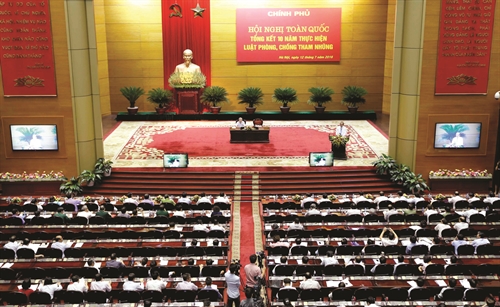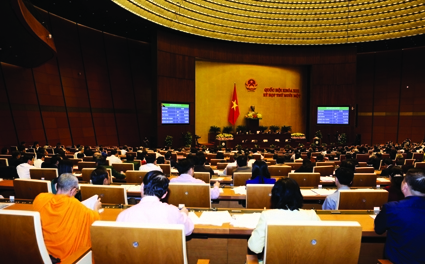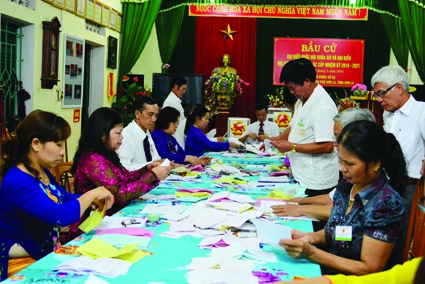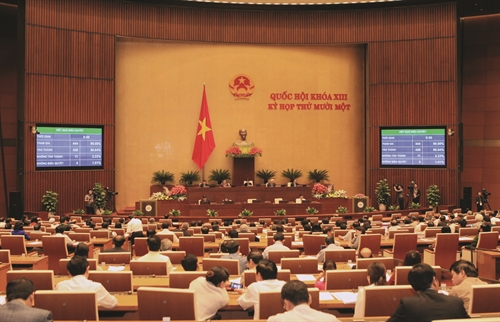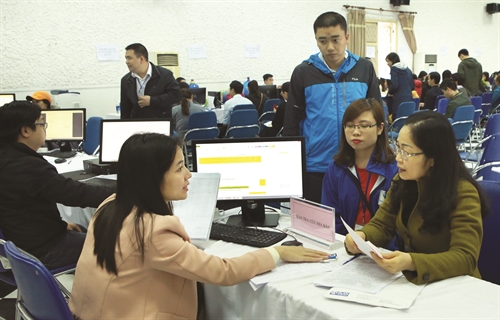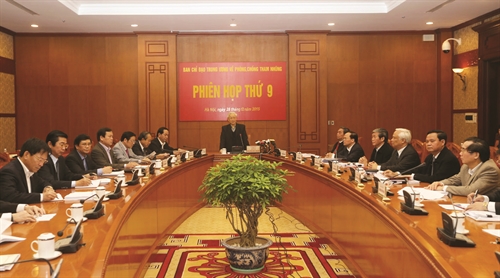Dr. Pham Chi Trung
Science and Technology Department
National Assembly Office
Current system of policies and laws concerning technology transfer
Vietnam now has a great number of legal documents directly and indirectly pertaining to technology transfer, including 13 codes and laws and 311 decrees and circulars. Among these, the most important is the Law on Technology Transfer, which was enacted in 2006. Other laws containing provisions on technology transfer activities include the Law on Science and Technology, Law on Intellectual Property, Law on Enterprises, Law on Investment, Law on Standards and Technical Regulations, Law on High Technology, and Law on Efficient Use of Energy, among others.
The country’s socio-economic development strategy for 2011-2020 has identified the tasks of “formulating and implementing a national program on technology renovation, adopting policies to encourage enterprises to import modern technologies, first of all in major and spearhead industries; giving priority to developing high technologies.”
Prime Ministerial Decision No. 1244/QD-TTg dated July 25, 2011, approving the main orientations, objectives and tasks of science and technology during 2011-2015, attaches importance to the formation of a system of technology transfer service, consultancy and brokerage organizations and organizations to promote transfer and commercialization of technologies, support the protection of intellectual property rights and enhance the exploitation and use of patents in universities and research institutes. It also sets the task of improving the operation of technology and equipment markets and technology exchanges.
The national strategy on science and technology development during the 2011-2020 period also highlights the necessity to develop technology transfer service organizations and technology and equipment markets, to ensure enforcement of the law on intellectual property and effective exploitation and use of patents, and to organize exhibitions to showcase achievements in science and technology renovation and creation.
Limitations in the current policies and laws concerning technology transfer
Overlaps and loopholes
Chapter V of the 2006 Law on Technology Transfer (the 2006 Law) assigns the management of technology transfer to various agencies, including the Ministry of Science and Technology, other ministries and agencies and local administrations. These agencies have issued numerous legal documents to regulate technology transfer activities in the areas under their respective management, such as science and technology, agriculture and rural development, investment and planning, construction, etc., thus causing difficulties to the implementation process.
Clause 1, Article 25 of the Law stipulates: “The parties to a technology transfer contract has the right to register their contract with a state management agency in charge of science and technology so as to enjoy incentives prescribed by this Law and other relevant laws.” This provision implies that, if finding it unnecessary, an enterprise that has a project involving technology transfer does not have to register its technology transfer contract.
Regarding appraisal of investment projects, Clause 1, Article 47 of the 2005 Law on Investment stipulates that domestic projects and foreign-invested projects capitalized at VND 300 billion (around USD 14 million) and projects on the list of conditional investment projects must undergo appraisal procedures in order to be issued investment certificates.
Therefore, investment projects worth under VND 300 billion and outside the list of conditional investment projects are not required to go through the technology appraisal procedures. Given the current situation that most of Vietnamese businesses are small- and medium-sized ones and their investment projects are mainly capitalized at below VND 300 billion and often import old or backward technologies which fail to satisfy environmental standards, the above provision has created a legal loophole in the management of technology transfer.
Government Decree No. 108/2006/ND-CP of September 22, 2006, detailing the Law on Investment lacks clear provisions on technology appraisal of investment projects. Point b, Clause 1, Article 45 of this Decree requires that the economic-technical explanations in a dossier for appraisal of an investment project must specify the project’s objective, size and location, investment amount, implementation schedule, land use need, technological solutions and environmental solutions. However, under Clause 3, Article 45, the issues to be appraised include conformity with planning, land use needs, implementation schedule and environmental solutions, but not technology. Therefore, it has become a common practice in localities that provincial-level Planning and Investment Departments would implement the provisions of Decree No. 108 of 2006 before transferring investment projects to provincial-level Department of Science and Technology for technology appraisal. As a result, most investment projects are granted investment certificates before they are appraised in terms of technology. This process is contrary to the Ministry of Science and Technology’s Circular No. 10/2009/TT-BKHCN of September 24, 2009, guiding the technology appraisal of investment projects.
Point b, Clause 1, Article 32 of the 2014 Law on Investment stipulates that provincial-level People’s Committees have competence to decide on investment policy of the projects which use technologies on the list of technologies restricted from transfer as prescribed by the law on technology transfer.
Point e, Clause 6, Article 33 of the 2014 Law on Investment on dossiers and procedures for decision on investment policy of provincial-level People’s Committees also requires the evaluation of technologies used in the investment projects mentioned at Point b, Clause 1, Article 32 of the Law.
The above provisions reveal another loophole in the evaluation and appraisal of technologies because many other projects using technologies which are not restricted from transfer will not be evaluated or appraised to determine whether their technologies are high or low or whether they would adversely affect the environment.
Impractical provisions
Clause 1, Article 6 of Decree No. 133 of 2008 detailing a number of articles of the Law on Technology Transfer stipulates: “Registration of a technology transfer contract is not mandatory…” Therefore, enterprises importing technologies for business or production purposes do not register them with local management agencies, making the management of transferred technologies impractical.
Regarding the implementation of provisions of Decree No. 49 of 2009 on sanctioning of administrative violations in technology transfer activities and Circular No. 04 of 2010 of the Ministry of Science and Technology guiding a number of articles of this Decree, reports from localities and ministries show that no violation in the field of technology transfer has been sanctioned so far.
Circular No. 35 of 2012 of the Ministry of Science and Technology provides guidance on making reports on technology transfer. In reality very few science and technology businesses and organizations make these reports.
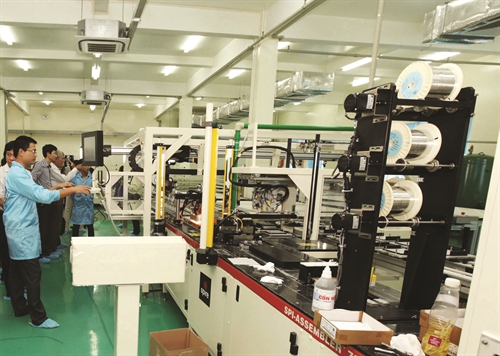 |
| Infrastructure facilities and equipment of the Research Center for Technology Transfer and Assessment in the Hoa Lac Hi-Tech Park (Hanoi) __Photo: Anh Tuan/VNA |
Problems in the implementation of the law on technology transfer
The process of implementation of the law and policies on technology transfer to serve socio-economic development and international integration in our country still reveals several problems.
Regarding registration and grant of certificates of technology transfer contracts, statistics from the Ministry of Science and Technology show that by the end of 2005, after eight years of implementation of the Law on Technology Transfer, the Ministry had granted these certificates to only nearly 300 contracts (Table 1), including 252 contracts of foreign direct investment (FDI) projects and some 40 independent contracts, of which 11 were registered by state agencies and business corporations.
Table 1: Statistics on technology transfer contracts from 2007 to 2015
| Year | Approved contracts | Registered contracts | ||||
| Registered by the MOST | Registered by local authorities | |||||
| FDI | Other | FDI | Other | FDI | Other | |
| 2007 | 82 | 7 | 2 | 10 | ||
| 2008 | 59 | 15 | 3 | 6 | ||
| 2009 | 32 | 3 | 9 | 25 | ||
| 2010 | 14 | 5 | 17 | 19 | ||
| 2011 | 14 | 2 | 15 | 17 | ||
| 2012 | 16 | 3 | 16 | 5 | ||
| 2013 | 11 | 3 | 10 | 12 | ||
| 2014 | 19 | 2 | 12 | 9 | ||
| 2015 | 14 | 2 | ||||
| Total | 0 | 0 | 252 | 42 | 84 | 103 |
(Source: Ministry of Science and Technology)[1]
The number of technology transfer activities carried out in reality is much more higher than that of the registered contracts shown above. There are some reasons for this situation:
First, the 2006 Law on Technology Transfer stipulates that registration of a technology transfer contract is voluntary, not compulsory. Project owners often do not sign separate technology transfer contracts but incorporate them into economic contracts on equipment procurement. Besides, no specific incentives are offered to organizations and individuals when they register their technology transfer contracts, albeit there is a policy in these incentives.
Second, the procedures for registration of technology transfer contracts are simple but cannot be carried out online yet, which has somehow discouraged the registration.
It should be noted that technology transfer contracts registered by FDI enterprises are mainly for carrying out technology transfer activities between overseas parent companies and their subsidiaries in Vietnam for the purpose of including technology transfer costs into production costs in order to reduce profits and taxes. However, how these technology transfer activities are implemented in Vietnam cannot be supervised yet.
According to the Ministry of Science and Technology, since 2007, out of registered 300 technology transfer contracts, only 19 are for domestic technology transfers[2]. This implies that domestic research institutes, organizations and individual have not yet paid due attention to the registration of technology transfer contracts when carrying out technology transfer activities. This also shows that the 2006 Law on Technology Transfer has just placed importance on the inflow of technologies while neglecting the transfer of research results between research institutes and businesses.
Moreover, the transfer of technologies from FDI projects to domestic businesses falls short of expectations because the localization rate remains low and supportive industries have not yet developed.
The recent years have seen an increasing number of offshore investment projects of Vietnamese enterprises, which, by the end of 2015, was 900 in 70 countries and territories, worth more than USD 21 billion in total.
Investment is associated with technology. Although Vietnam is still a developing country, a number of locally developed technologies have been highly valued by foreign countries. Nevertheless, the 2006 Law lacks clear and specific provisions on the outbound transfer of technologies, especially those funded by the State. Therefore, over the past time the Ministry of Science and Technology and local administrations have not yet registered and issued certificates to any contracts on overseas transfer of locally developed technologies.
Technology inspection, evaluation and valuation services play a crucial role in the success of technology transfer activities in particular and the development of the technology market in general. Providers of these services must be qualified in order to be able to deliver these services effectively. However, the 2006 Law on Technology Transfer 2006 only classifies the technology inspection service as a conditional one. This has caused not a few difficulties to the management and operation of technology transfer service organizations.
Due to the overlaps and loopholes in the legal system on technology transfer, the management agencies in charge of technology have not been consulted right from the beginning of the process of grant of investment certificates, except investment projects subject to certain conditions or Prime Minister approval.
As a result, according to local administrations’ reports, a lot of obsolete and polluting technologies have been transferred and installed in projects. At the end of 2011, China announced its plan to shut down 2,255 enterprises using obsolete technologies, machinery and equipment. Unless Vietnam introduces and enforces strict regulations, especially on the appraisal of projects accompanied by technologies, these obsolete technologies would find their way into our country.
The 2006 Law on Technology Transfer prescribes three lists of technologies encouraged for transfer, restricted from transfer and banned from transfer, which are promulgated by the Prime Minister. The Ministry of Science and Technology is assigned to issue criteria and processes for identifying the technologies on these three lists.
Given the fast development of science and technology, these lists should be regularly updated. However, the updating of these lists must comply with a time-consuming legislative process, thus affecting the implementation of the Law on Technology Transfer.
Technology transfer is not only related directly to machinery and equipment but also to intangible assets and intellectual property rights such as patents, formulas, trademarks, labels and technical data. In Vietnam, the purchase and sale and valuation of intangible assets have been carried out. However, Vietnamese law has not yet established methods of valuation of intangible assets, including intellectual property rights, therefore posing problems to technology transfer activities in the past time.
Proposed solutions
Improving the current system of policies and laws concerning technology transfer and properly implementing these policies and laws in reality have become imperative for Vietnam in the period of economic restructuring and international integration.
Following are a number of proposals for improving Vietnam’s legal system on technology transfer in the coming time.
Firstly, regarding the Law on Technology Transfer, it is urgent to add provisions on the transfer of domestic technologies, focusing on transfer of the rights to own and use the results of research projects funded by the State, and provisions on technology transfer from Vietnam to abroad. It is also necessary to revise provisions on transfer of technologies from abroad into Vietnam, especially the transfer of technologies from FDI projects to local businesses.
Provisions on coordination among agencies, sectors and localities in the management of technology and technology transfer; on the decentralization of the management of technology transfer activities should be also revised to enhance post-inspection work.
The Ministry of Science and Technology should be assigned to issue the three lists of technologies mentioned above.
As discussed above, the technology appraisal and valuation services should be regarded as conditional businesses and the provision of these services should be regulated more strictly.
Secondly, regarding the Law on Intellectual Property, the provisions on methods of valuation of intangible assets and on subject matters of industrial property should be added in conformity with the Paris Conventions and TRIPS Agreement as well as with regulations of the WTO, FTAs and TPP. Besides, provisions on enforcement of intellectual property rights and on settlement of IP disputes via negotiation and conciliation should be added.
Thirdly, provisions on technology transfer in the Law on Handling of Administrative Violations should be amended in order to prevent and handle tax fraud, tax evasion and transfer pricing in technology transfer activities.
Fourthly, the laws on investment and enterprises, high technology, trade and customs should be revised toward making technology appraisal compulsory for all kinds of investment projects before they are granted investment certificates. Registration of technology transfer contracts should also be regarded as a mandatory requirement.
Finally, the law on science and technology, enterprises, credit, tax and venture investment should be modified to encourage and promote technology transfer, application, renovation and creation activities in enterprises.-
